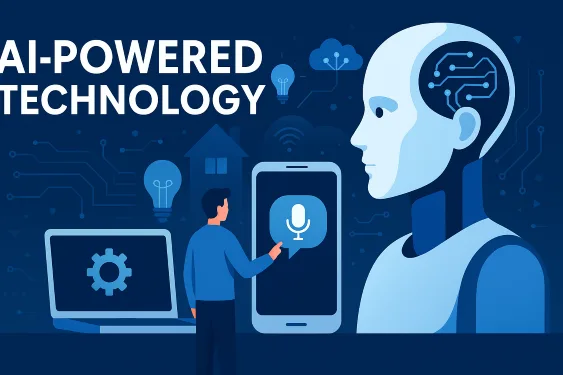In 2025, AI-powered technology is no longer a futuristic concept—it’s the foundation of how we live, work, and interact with the world around us. From the smartphones in our pockets to the cars we drive and even the way we receive medical care, artificial intelligence (AI) has become a transformative force across every aspect of modern life.
This article dives into the most profound ways AI-powered technology is shaping daily experiences, revealing how it’s driving efficiency, improving safety, and personalizing services at an unprecedented scale.
The Evolution of AI: From Hype to Reality
AI has come a long way from the buzzwords of the 2010s. Thanks to powerful advancements in deep learning, natural language processing (NLP), and machine vision, AI has evolved from mere automation to decision-making systems that mimic human intelligence.
In 2025, AI is more than an assistant—it’s a collaborator. It learns, adapts, and makes context-driven decisions in real time, offering intelligent solutions across sectors including healthcare, finance, education, transportation, and home automation.
AI in Healthcare: Personalized and Predictive Medicine
One of the most impactful applications of AI-powered technology is in healthcare. AI algorithms are now capable of detecting diseases earlier than ever. Machine learning models trained on millions of patient records help doctors predict conditions like cancer, diabetes, and heart disease even before symptoms appear.
Telemedicine platforms now feature AI chatbots that handle initial patient queries, reducing strain on doctors and speeding up response times. Moreover, wearable health devices track vital signs and transmit data to cloud-based AI systems for real-time analysis, enabling preventive healthcare.
Smart Homes and AI Assistants
AI has turned our homes into intelligent living spaces. Smart home systems powered by AI can learn user habits and adapt lighting, temperature, and security settings accordingly. Voice assistants like Alexa, Siri, and Google Assistant are now smarter, with contextual understanding and multi-language capabilities.
These AI assistants can manage schedules, order groceries, control appliances, and even offer mental health support by recognizing changes in speech tone or behavior.
AI at the Workplace: From Automation to Augmentation
The workplace of 2025 is drastically different, with AI-powered technology automating repetitive tasks and freeing employees to focus on creativity and problem-solving. AI tools now write code, draft legal documents, manage inventories, and even make hiring decisions.
Large language models (LLMs), like the ones used in ChatGPT, are now embedded into business platforms, offering real-time support for customer service, sales, content creation, and data analysis. AI isn’t replacing humans—it’s amplifying their potential.
AI in Transportation: Self-Driving and Safer Roads
Autonomous vehicles, once experimental, are now on the roads of major cities around the world. AI handles navigation, traffic prediction, and real-time obstacle detection, reducing accidents and improving fuel efficiency.
Ride-sharing services and logistics companies are using AI to optimize routes, reduce emissions, and cut delivery times. Drone-based delivery systems, powered by AI, are increasingly common in urban areas, redefining the last-mile delivery ecosystem.
AI in Education: Adaptive and Inclusive Learning
Educational institutions are leveraging AI-powered technology to create personalized learning experiences for students. Adaptive learning platforms assess student performance in real time and adjust lessons accordingly, catering to different learning styles and paces.
AI tutors offer 24/7 support, while language translation systems break down linguistic barriers, making education more accessible globally. Even administrative tasks—like grading and attendance tracking—are now handled by AI, giving educators more time to focus on teaching.
Ethical AI: The Challenges Ahead
With great power comes great responsibility. As AI becomes deeply embedded in daily life, ethical concerns around bias, privacy, and job displacement continue to surface.
Governments and organizations are now prioritizing the development of explainable, transparent, and fair AI systems. Regulatory frameworks are emerging to ensure that AI-powered technology respects human rights and operates within legal boundaries.
There is also a growing demand for AI literacy among citizens, emphasizing the need for awareness and understanding of how AI systems make decisions.
What’s Next?
Looking forward, the integration of AI-powered technology with other emerging fields like quantum computing, biotechnology, and augmented reality promises to unlock even more revolutionary changes.
Imagine AI diagnosing diseases based on genetic data, managing sustainable energy grids in smart cities, or enhancing virtual reality experiences to blur the line between digital and physical worlds.
Conclusion
The age of AI-powered technology is here, and it’s only just getting started. As AI continues to evolve and integrate deeper into our lives, it’s redefining the way we work, communicate, and make decisions.
While the opportunities are vast, the focus moving forward must be on responsible innovation—ensuring that AI remains a tool for empowerment, inclusion, and human progress.
